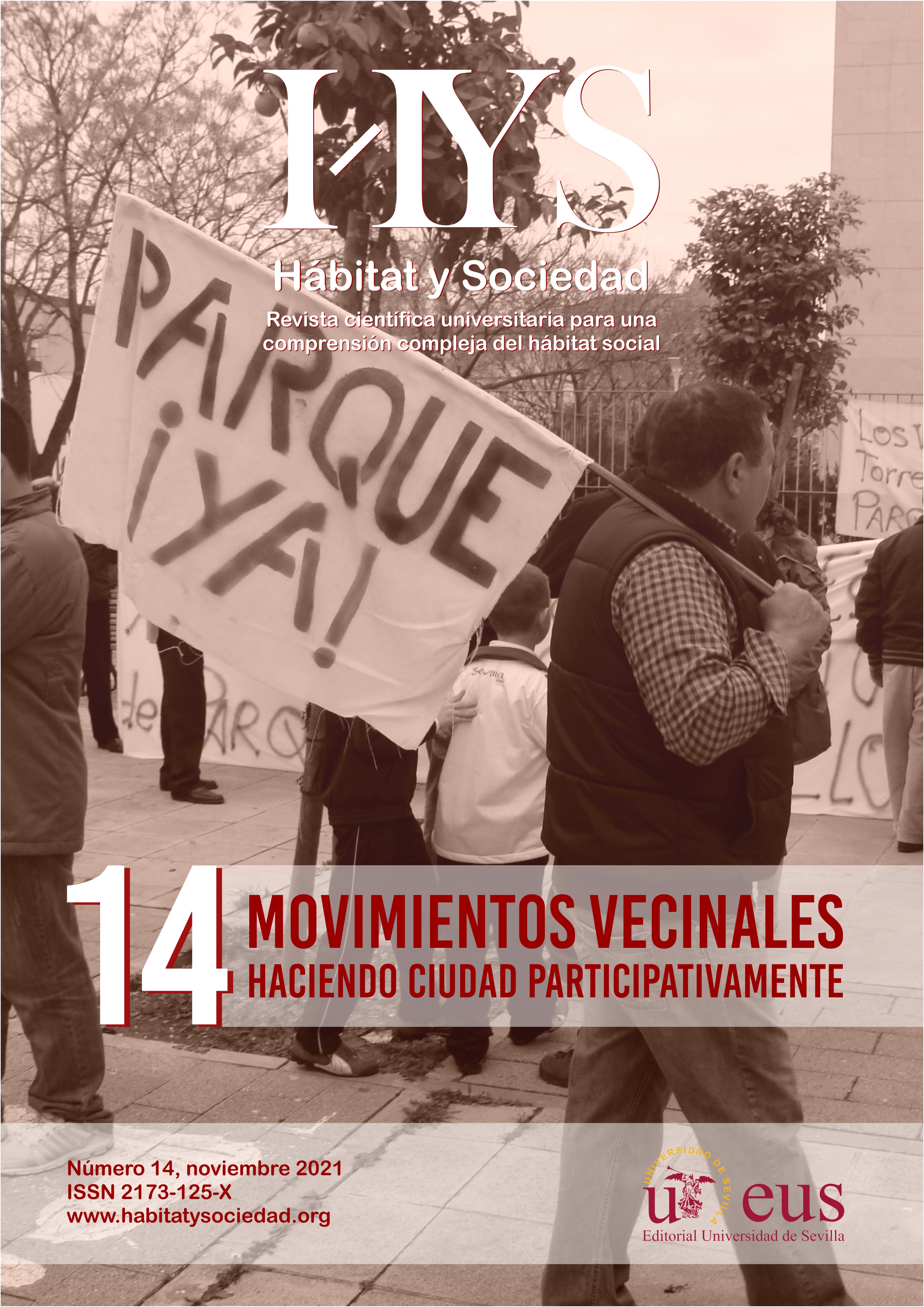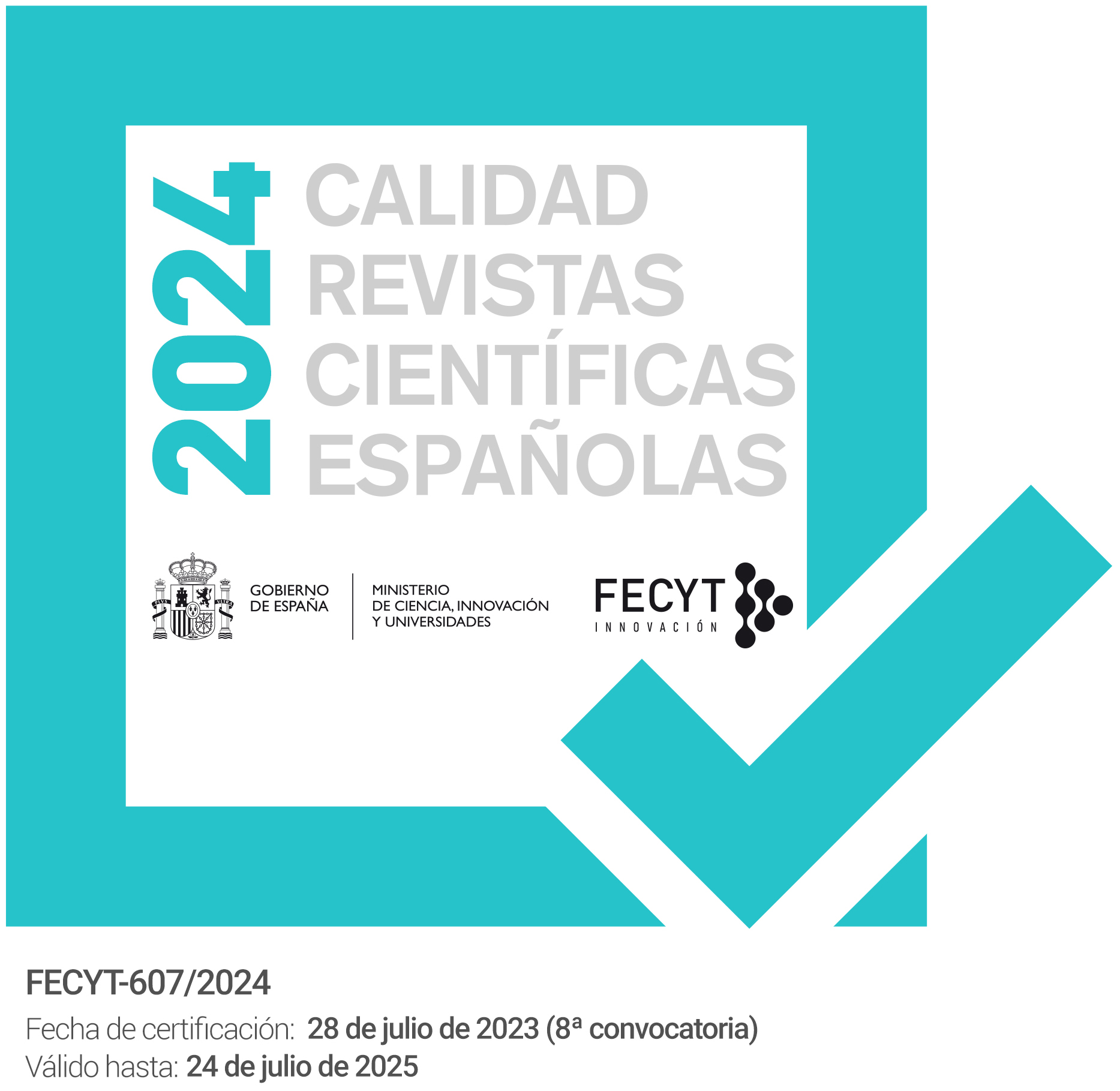Pedaleando con Lefebvre por el carril-bici de Sevilla. Por qué no debemos presuponer que las infraestructuras públicas restringen por defecto el derecho a la ciudad
DOI:
https://doi.org/10.12795/HabitatySociedad.2021.i14.14Palabras clave:
Producción del espacio, Urbanismo, Infraestructuras urbanas, TransporteResumen
Ante la común confusión sobre la noción presuntamente lefebvriana de que toda obra pública ha de tener, por defecto y de forma inevitable, un carácter coactivo que cercena el derecho a la ciudad de los habitantes -y dado que esa errónea premisa suele aplicarse, no infrecuentemente, a dotaciones para una ciudad más habitable, tales como las que promueven el ciclismo urbano- se hace necesario examinar las reiteradas excepciones que el propio Lefebvre enuncia a lo largo de su obra cuando caracteriza aquellas intervenciones urbanísticas que, al cumplir ciertas condiciones, fortalecen el espacio vivido en nuestras urbes. Nos proponemos no sólo enumerar dichos apuntes de Lefebvre, a menudo obviados, sino ilustrarlos tomando como modelo una intervención urbanística de gran repercusión como fueron las dotaciones de promoción del ciclismo urbano en la ciudad de Sevilla en la pasada década, y aplicando a sus características dichas contribuciones lefebvrianas. En la pugna por las estrategias de producción del espacio, infraestructuras como la abordada en el presente estudio de caso garantizan el derecho a la ciudad, en lugar de suponer, como podría argüirse desde la lectura superficial del análisis de Lefebvre, un elemento que restrinja ese derecho.
Descargas
Citas
A Controamano (2008). 21 años en defensa de una mo¬vilidad más sostenible. Sevilla: A Contramano- Asam¬blea Ciclista. Recuperado el 20 de enero de 2021 de: http://www.acontramano.org/antigua/noti¬cias/memoria-web-1.pdf.
Augé, Marc (2009). Elogio de la bicicleta. Barcelona: Ge¬disa.
Ayuntamiento de Sevilla (2010). Estudios sobre el uso de la bicicleta en la ciudad de Sevilla. Recuperado el 23 de enero de: http://www.acontramano.org/in-dex.php?option=com_joomdoc&task=document. download&path=conteos-e-informes-del-uso-de-la-bici-en-sevilla%2F2009-conteo-de-ciclistas-en-no¬viembre-de-2009-y-estimacion-del-numero-de-des¬plazamientos-en-bicicleta&Itemid=62.
Bourdieu, Pierre (1998). La distinción: criterios y bases sociales del gusto. Madrid: Taurus.
Bourdieu, Pierre (2008). El sentido práctico. Madrid: Si¬glo xxi.
Calvo Salazar, Manuel (2013). Movilidad sostenible en nuestras ciudades. Sevilla: Universidad de Sevilla.
Castells, Manuel (1986). La ciudad y las masas: sociología de los movimientos sociales urbanos. Madrid: Alianza Editorial.
Castells, Manuel (1988). La cuestión urbana. Madrid: Si¬glo xxi.
Castells, Manuel (2001). La Galaxia Internet. Reflexiones sobre Internet, empresa y sociedad. Barcelona: Plaza & Janés.
Castillo Manzano, José I., y Sánchez Braza, Antonio (2013). Can anyone hate the bicycle? The hunt for an optimal local transportation policy to encourage bicycle usage. Environmental Politics, 22, 1010-1028. DOI: https://doi.org/10.1080/09644016.2012.740 936.
Costes, Laurence (2012). Del ‘derecho a la ciudad’ de Henri Lefebvre a la universalidad de la urbaniza¬ción moderna. Urban, 2, 89-100. Recuperado el 20 de enero de 2021 de: http://polired.upm.es/in¬dex.php/urban/article/view/1495/1990
Gaviria, Mario (2006). La Bicicleta, ambientalmente perfecta. Auzolan, Hoja Informativa del Colegio Nava¬rro de Sociólogos y Politólogos, 7, 5. Recuperado el 23 de enero de 2021 de: http://www.colsocpona.org/ documentos/premios/2006/Bicicleta.pdf.
Gehl, Jan y Gemzøe, Lars (2002). Nuevos espacios urba¬nos. Barcelona: Gustavo Gili.
Gottdiener, Mark y Hutchison, Ray (2011). The New Ur¬ban Sociology. Boulder: Westview Press.
Hanson, Royce y Young, Garry (2008). Active li¬ving and biking. Tracing the Evolution of a Bi¬king System in Arlington, Virginia. Journal of Health Politics, Policy and Law, 33(3), 387-406. DOI: 10.1215/03616878-2008-002.
Hernández, Macarena y Huerta, Elena (2016). La ciu¬dad desde la bicicleta. En Hernández, Macarena (Ed.), Bicitopías. Hacia una antropología de la movili¬dad urbana (pp. 11-28). Barcelona: Icaria.
Horton, Dave (2006). Environmentalism and the bi¬cycle. Environmental Politics, 15(1), 41-58. DOI: 10.1080/09644010500418712.
Horton, Dave, Rosen, Paul y Cox, Peter (Eds.) (2007). Cycling and Society. Aldershot: Ashgate Publishing.
Kidder, Jeffrey L. (2009). Appropriating the city: spa¬ce, theory, and bike messengers. Theory and Socie¬ty, 38(3), 307-328. DOI: https://doi.org/10.1007/ s11186-008-9079-8.
Lefebvre, Henri (1978). El derecho a la ciudad. Barcelo¬na: Península.
Lefebvre, Henri (1983). La revolución urbana. Madrid: Alianza Editorial.
Lefebvre, Henri (2006). Writings on cities. Cambridge: Blackwell.
Lefebvre, Henri (2013). La producción del espacio. Ma¬drid: Capitán Swing.
Malpica, Pedro (2020). La influencia del campo social pro-bicicleta en el proceso de promoción del ciclis¬mo urbano en Sevilla. Hábitat y Sociedad, 13, 151- 168. DOI: 10.12795/HabitatySociedad.2020.i13.09.
Marqués, Ricardo (2011). Sevilla: una experiencia exi¬tosa de promoción de la movilidad en bicicleta en el Sur de Europa. Hábitat y Sociedad, 13, 107-130. DOI: 10.12795/HabitatySociedad.2011.i3.07.
Marqués, Ricardo, Hernández Herrador, Vicente, Cal¬vo Salazar, Manuel y García Cebrián, José Antonio (2015). How infrastructure can promote cycling in cities: Lessons from Seville. Research in Trans¬portation Economics-El selvier, 53(C), 31-44. DOI: 10.1016/j.retrec.2015.10.017.
Rodríguez Díaz, Álvaro (2008). El deporte en la construc¬ción del espacio social. Madrid: Centro de Investiga¬ciones Sociológicas.
Sanz, Alfonso (2008). Calmar el tráfico. Pasos para una nueva cultura de la movilidad urbana. Madrid: Centro de Publicaciones del Ministerio de Fomento.
Torres Elizburu, Roberto (2003). La bicicleta dentro de la movilidad urbana. El caso de Vitoria-Gasteiz. Lurralde. Investigación y espacio, 26, 103-121. Recu¬perado el 23 de enero de 2021 de: http://www.in¬geba.org/lurralde/lurranet/lur26/elizbu26/eliz-bu26.htm.
Weikart, Will (2006). Critical Multitude, War Machine: What the Left can Learn, and the Right May Have Already Learned, from a Bunch of Bicyclists. Situa¬tions: Project of the Radical Imagination, 1(2), 93-116.
Publicado
Cómo citar
Número
Sección
Licencia
Derechos de autor 2021 De los autores y Editorial Universidad de Sevilla

Esta obra está bajo una licencia internacional Creative Commons Atribución-NoComercial-CompartirIgual 4.0.
Los textos publicados se considerarán propiedad intelectual de los autores y de la revista. Podrán ser usados para usos educativos y académicos, citando al autor y la publicación, con la dirección electrónica exacta. En todo caso, deberá comunicarse este tipo de uso y pedir la autorización del mismo a la dirección de la revista.
Los autores/as que publiquen en esta revista aceptan las siguientes condiciones:
- Los autores/as conservan los derechos de autor y ceden a la revista el derecho de la primera publicación, con el trabajo registrado con la licencia de atribución de Creative Commons, que permite a terceros utilizar lo publicado siempre que mencionen la autoría del trabajo y la primera publicación en esta revista.
- Los autores/as pueden realizar otros acuerdos contractuales independientes y adicionales para la distribución no exclusiva de la versión del artículo publicado en esta revista (p. ej., incluirlo en un repositorio institucional o publicarlo en un libro) siempre que indiquen claramente que el trabajo se publicó por primera vez en esta revista.
- Se permite y recomienda a los autores/as publicar su trabajo en Internet (por ejemplo en páginas institucionales o personales) antes y durante el proceso de revisión y publicación, ya que puede conducir a intercambios productivos y a una mayor y más rápida difusión del trabajo publicado (véase The Effect of Open Access).













